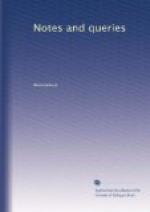“During the first five ages, the name of the Anicians was unknown. The earliest date in the annals of Pighius is that of M. Anicius Gallus, Tr. Plebis A.U.C. 506. Another Tribune, Q. Anicius, A.U.C. 508, is distinguished by the epithet Praenestinus.”
We learn from Pliny, H.N. xxxiii. 6., that Q. Anicius Praenestinus was the colleague as curule aedile of Flavius, the famous scriba of Appius Caecus, B.C. 304, A.U.C. 450. (See Fischer, Roem. Zeittafeln, p. 61-2.) Pliny’s words are—
“[Flavius] tantam gratiam
plebis adeptus est ... ut aedilis
curulis crearetur cum Q. Anicio
Praenestino.”
Gibbon’s chapter on Mahomet seems to be particularly superficial; it is to be hoped that a future editor will correct it by the aid of Von Hammer’s labours.
J.E.B. MAYOR.
Marlborough College.
* * * * *
MINOR NOTES
"Ockley’s History of the Saracens,” and unauthentic Works.—At the end of a late edition of Washington Irving’s Life of Mahomet, those “who feel inclined to peruse further details of the life of Mahomet, or to pursue the course of Saracenic history,” are referred to Ockley. Students should be aware of the character of the histories they peruse. And it appears, from a note in Hallam’s Middle Ages (vol. ii. p. 168.), that Wakidi, from whom Ockley translated his work, was a “mere fabulist,” as Reiske observes, in his preface to Abulfeda.
Query, Would it not be well, if some of your more learned correspondents would communicate to students, through the medium of “NOTES AND QUERIES,” a list of such books as are genuine but not authentic; and authentic but not genuine, or altogether spurious? or would point out the sources from which such information can be obtained?
P.H.F.
The Hippopotamus.—Your correspondent L. (Vol. ii., p. 35.) says, “None of the Greek writers appear to have seen a live hippopotamus:” and again, “The hippopotamus, being an inhabitant of the Upper Nile, was imperfectly known to the ancients.” Herodotus says (ii. 71.) that this animal was held sacred by the Nomos of Papremis, but not by the other Egyptians. The city of Papremis is fixed by Baehr in the west of the Delta (ad ii. 63.); and Mannert conjectured it to be the same as the later Xois, lying between the Sebennytic and Canopic branches, but nearer to the former. Sir Gardner Wilkinson says, several representations of the hippopotamus were found at Thebes, one of which he gives (Egyptians, vol. iii. pl. xv.). Herodotus’ way of speaking would seem to show that he was describing from his own observation: he used Hecataeus, no doubt, but did not blindly copy him. Hence, I think, we may infer that Herodotus himself saw the hippopotamus, and that this animal was found, in his day, even as far north as the Delta: and also, that the species is gradually dying out, as the aurochs is nearly gone, and the dodo quite. The crocodile is no longer found in the Delta.




